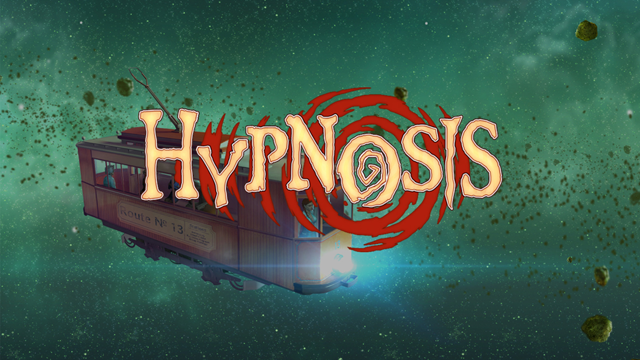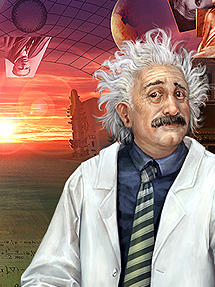Post-mortem of the game "Hypnosis"
Today the game “Hypnosis” was released on iOS. This is a big and bright quest that the internal studio of Nevosoft has been working on for more than two years. Alexey Serebrov, Director of the Nevosoft Development Department, told us about the stages of development, mistakes and victories.

Hypnosis is a game about people’s fears and dreams
It all started in hot August 2010. It began, as it often happens, with the end. We had just frozen the sequel to the Mushroom Era, a psychedelic project in the genre of “I’m looking for”. We stopped developing it for many reasons. One of them is the desire to go beyond the usual framework of casual games, to develop a project in which the main character with his experiences would come out on top.
Root Causes
The essence of most projects in the genre of “I’m looking for” is that the player studies the game world in them. A simple image of the main character (for example, the heir of an abandoned estate) is easily projected, does not create cognitive dissonances.
We also wanted to bring drama into the game, a real conflict, so that the player would not so much get used to the image, as he would begin to empathize with the main character, the hero. And with the help of this, to convey to the player, in general, a simple idea that each of us perceives reality in his own way.
So the idea arose to create a classic third-person quest with simple riddles. However, even at the concept stage, it became clear that only an adventure core would not be enough. The conflict implies not just a clash of characters and opinions, but sometimes an armed confrontation. So we decided to add a combat component to the game – a full-fledged combat system.

Such a combat system eventually became
It was the fall of 2010, three people were allocated to create the initial prototype in Nevosoft, we can say, a “battle group”, which began experimenting with the quest part – with how it could work on various platforms. Moreover, not only mobile, but also console systems were taken into account.
Therefore, we immediately abandoned the introduction of full-fledged action elements. Firstly, in this case it would definitely not be a quest, and secondly, this approach would complicate the work with the UI. Considering that from the very beginning we planned to make the game multiplatform, we would have to conjure up control in each individual case, not only change the size of buttons, menus, but also completely rework the logic of the interface. We did not do this consciously.
The solution was found almost immediately: a separate combat mode was created. Initially, we started from the concept of Final Fantasy. In most of the games in this series, the hero travels to locations, interacts with NPCs, and at the moment of the fight there is a separate battlefield on which the battle takes place.
Since we were primarily focused on the audience of casual games, the combat mode could not be some kind of analog of a turn-based strategy, with a large number of tricks, using spells, creatures, cards and everything else, as in the case of Final Fantasy. It was also no sense to make it conditional, of course.
We decided to add a full-fledged mini-game, and began sorting through the options. There were a lot of them, but most of us were not satisfied. For example, doing Match 3 at that time seemed to us something inappropriate. There was, to put it mildly, an excess of them on the casual market. As a result, we settled on the mechanics of our hit Land Grabbers as the basis. It was a very bold experiment for us: to mix an almost classic adventure game with an arcade puzzle.

Gameplay of Land Grabbers
But, importantly, in the process of transferring the mechanics of Land Grabbers, we, as often happens, have greatly modernized it. As a result, it became more puzzling. Looking ahead, it turned out to be so successful in its new interpretation that in the future we took up the development of a separate project, where it already acted as the fundamental mechanics.
From concept to first release
With the combat mechanics ready and the original engine created, we came to the beginning of 2011. By this time, the basic things that would still get into the project had already been determined, the plot was determined: a female psychiatrist wanders through the inner worlds of her patients.
Initially, the hero of the game was supposed to be Professor Einbok, who got into the final version as one of the NPCs. In the first months of development, we contemplated his walking in the prototype. We can say that this is how the continuity between the “Mushroom Era”, where he was also present, and “Hypnosis” was preserved. The hero was such a funny scientist in slippers, outwardly resembling Einstein, and in behavior more like Lieutenant Columbo, who, in appearance, is a terrible clumsy, but in fact clicks like nuts detective cases.

Professor Einbok
But in the end he gave way to Maya. From the point of view of marketing, a woman is a more successful character, her story can resonate with more users than a funny old man. In addition, we wanted to add a romantic line to the game. In the case of Einbok, this would be much more difficult to do. Unless, to take as a basis Sofia Coppola’s film “Translation Difficulties”, but, as the Strugatskys would write, “this is a completely different story.”
The idea of the main character-a psychiatrist, as well as the desire to convey to the players the idea of the difference in the perception of different people allowed us to go on another bold experiment: to get away from a single style in the game. We have a different approach to style not only in the setting, in the design of locations, but even in the manner of their image. The programmer’s world is drawn in the style of squeak art, there is only a place for formulas in Einbok’s head, and the locations of the “real” world are copied from Lynch’s ”Twin Peaks”.

Sketch for the main location
By the summer of 2011, the plot and all the dialogues were completely written, and by the end of autumn, all the content was completed: heroes, locations, enemies, and so on. In winter, the process of bringing it all together began. It became much easier to work on the project, because the time of constant brainstorming has passed, when the full team (there were already 8 of us) sat down in a circle and thought about riddles, the style of locations, how the characters should look.
So gradually, week after week, the game acquired a finished look. Locations were combined into a chain, phobias learned to fly, the balance was adjusted in the combat system. In the spring of 2012, we translated the game into English, took up voice acting, began to show “Hypnosis” to our colleagues and carefully study their reaction to the project.
And quite unexpectedly, at the stage of internal testing, we encountered one problem. Our combat system, as it turned out, introduced a certain dissonance into “Hypnosis”. While the quest component was suitable for both female and male audiences, the “action” was ambiguously perceived by the fair sex.

The opponents in the game are serious
Because of this, we had to make battles with Maya’s opponents optional in the game. It was not an easy decision, but in the current situation, it seems to us, the most correct one. In fact, the player became free to decide whether he wants to break his head over the solution of the riddle, thereby fighting a phobia, or, if he is very impatient, quickly return to the quest and unravel what caused the mass hallucinations in a psychiatric clinic.
In July 2012 , the game was released in the PC version on Nevosoft.ru in Russian. However, at that time we already understood that for us it was just a trial run. Our main platform was supposed to be iOS, and there are plans to launch the game on consoles.
Time Trial
From a technical point of view, it is not difficult to transfer the game to smartphones and tablets. Of course, we have to work on optimization, abandon animation on loading screens, simplify effects in some places, but, to be honest, anyone who has transferred a game from one platform to another at least once faces this.
The main difficulties were in another – in management and monetization. The game had to be intuitive and understandable to the user, as well as support IAP. We weren’t going to make the game free. But, what is important, even distributing your project for $ 4.99, the developer today should give the user the opportunity to pay more.

One of the game worlds
Monetization of “Hypnosis” is, to put it mildly, very gentle. The in-game currency – crystals – is relevant only for the combat mode, which, we remind, can be skipped. But if the user wants to complete all combat missions, he must buy new combat skills. To purchase them, however, it is absolutely not necessary to spend real money. For completing all the early missions “for three stars”, the player will receive enough crystals to buy the necessary skills. You can also buy Maya’s costumes for crystals. And they cost really a lot – it’s easier to pay a couple of bucks.
By the way, the most expensive costume was called Forbidden dream, but it is not in the final version – the editors of the App Store asked to remove it.

Apple didn’t like our fantasies
Management is also a separate story. It is believed that point and click quests are easy to transfer to mobile platforms. They say, instead of the cursor, the user uses a finger. At first glance, everything is as it is. And now compare the size of the cursor in relation to the game screen and the size of the finger: the latter, firstly, obscures half of the screen, and secondly, unlike the cursor, it cannot react to active objects on the screen. And there are dozens of such little things. And everything had to be taken into account and caught so that interaction with the game did not cause irritation, as, unfortunately, happens in the case of not the most successful ported games, but only positive emotions.
We spent a little more than six months on this, as well as on thorough testing, at the same time starting the next major project, as the basis of which we took our combat system. But that’s a completely different story.
From today, “Hypnosis” is available on i-devices. We are sure that the game will find its audience – those who know a lot about the good old quests, who need to get to the bottom of it, who, like us, are drawn to look into the heads of people around them and find out what they are hiding.